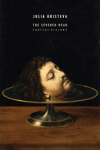The Severed Head
I never forgot that photo. It was in a history of the Metropolitan Opera, and soprano Olive Fremstad was Salome holding the platter with John the Baptist’s head. Even by 1907 standards, her beaded costume and big hair were beyond camp, but to my teenaged self the waxy, dead head looked real enough. I was sufficiently creeped out to avoid Richard Strauss’ opera until adulthood, when I discovered Salome’s true horrors: placing unrealistic demands on its lead to perform a striptease to music that’s impossible to dance—let alone time the tearing off of seven veils—to, before singing a punishingly long monologue to the Baptist’s head prior to kissing it (gross . . . even if it should resemble Bryn Terfel, a recent Met Baptist). With the exception of Electra, Richard Strauss was never again so creatively daring.
I never forgot that photo. It was in a history of the Metropolitan Opera, and soprano Olive Fremstad was Salome holding the platter with John the Baptist’s head. Even by 1907 standards, her beaded costume and big hair were beyond camp, but to my teenaged self the waxy, dead head looked real enough. I was sufficiently creeped out to avoid Richard Strauss’ opera until adulthood, when I discovered Salome’s true horrors: placing unrealistic demands on its lead to perform a striptease to music that’s impossible to dance—let alone time the tearing off of seven veils—to, before singing a punishingly long monologue to the Baptist’s head prior to kissing it (gross . . . even if it should resemble Bryn Terfel, a recent Met Baptist). With the exception of Electra, Richard Strauss was never again so creatively daring.
Julia Kristeva begins The Severed Head with her own first encounter with a headless body, a picture drawn by her mother of a melting snowman “as though severed by the invisible guillotine of the sun.” Her indelible childhood image is the starting point for the exhibit Kristeva—a novelist, professor, and political scientist—curated for the Louvre on the art of decapitation. Creepy? Definitely. But this is not an exhibition catalogue that might upset sensitive children, squeamish adults, or opera fans who like their favorite bass-baritones intact. Rather, The Severed Head is an intellectually rigorous overview of why this particular image continues to haunt artists and viewers alike.
Like the non-confrontational, user-friendly periods of art history (Egyptian, Renaissance, French Impressionism, celebrity fashion designers) that are selling points for museum exhibits and coffee table books, there is a long tradition of decapitation; every era has a culture that specialized in it. Obviously, a head detached from its body is sensational. Kristeva knows this and uses The Severed Head as a reminder that
The horror of these decapitations and the impact of their reproductions inevitably evokes for us the photographs and televised reports of recent civil wars. In Biafra, Vietnam, and again, now, in Rwanda and Algeria, where fundamentalists currently practice slaughter and slice throats. So frequent are these practices in some areas of the world that global opinion, initially shocked, eventually shuts its eyes.
Kristeva thus commences her tour, an always engaging combination of history, theology, anthropology, literature, and art. Readers should find her references interesting enough to investigate on their own. Because the curator/author is based in France, it is not surprising that the French Revolution is examined in lurid detail. Not only was there public debate on the invention of the guillotine, but “rules of art” were applied to its creation; its inventor, Tobias Schmidt, was a harpsichord maker.
The author is extremely thorough connecting religious images of dead/ floating heads that might at first seem incredulous. She observes rather striking similarities between the Greek Medusa of freezing stare and flowing serpent locks and Jesus Christ:
But we know that Gorgon heads in particular were still reproduced on objects from the Byzantine period and continued to serve as talismans. Bearded masks with long curly tresses that recall the image of certain Gorgons . . . and Christ on the mandylion [holy image] are sometimes found in Edessan [ancient Mesopotamian] buildings from the second and third centuries.
Kristeva makes another parallel between the two: that Christ’s image was used for indoctrination and fear of damnation and Medusa’s to reinforce a fear of women and sex (i.e., castration).
There are three female biblical characters that evoked—and provoked—the same reactions as Medusa. Kristeva names Delilah, Judith, and Salome as “female avengers” with specific axes to grind against a wartime enemy, slavery, and dysfunctional family, respectively. The Severed Head is not even 200 pages long, but it is no abbreviated catechism either. The author succinctly recounts each woman’s story using strong secular sources including the historian Flavius Josephus and Flaubert, a womanizer who struggled completing Herodias (the mother of Salome, who made her ask for the Baptist’s head as reward for her dance) because, as he said, “I am sick of the fear that Salome’s dance inspires in me!”
Kristeva’s best argument for the serious re-examination of biblical bloodbaths is Artemisia Gentileschi’s Judith. A female Renaissance artist, Artemisia continues to be treated as either a politically correct art history reference or rape victim who took out her anger on her attacker/husband out on her canvas. There is nothing politically correct about her art or her painting of Judith and her maid holding down the drunken Assyrian general Holofernes as they slice off his head with a sword. Again, Kristeva chooses her words well:
The important thing that is that she painted like no other woman before or after her, and she did not paint just anything, but a well and truly a violated man—and even better: decapitated by her own hand, the brilliant Artemisia!
Artemisa’s Judith is angry and determined. By comparison, Klimt’s Judith is an ugly, spoiled rich woman high on morphine.
Anne Boleyn, Mary of Scotland, and Marie Antoinette form a famous trio of beheading victims whose biographies have been fictionalized, romanticized, and bowdlerized. Kristeva mentions them in passing in favor of making the larger point that decapitating a ruler debunked the “sacred” aura of royalty, for “the fact remains that the closer we come to modern times, the more decapitations becomes the concern of men.”
Which is why The Severed Head is a reminder that art can be the best teacher, particularly when the topic is an uncomfortable one.





